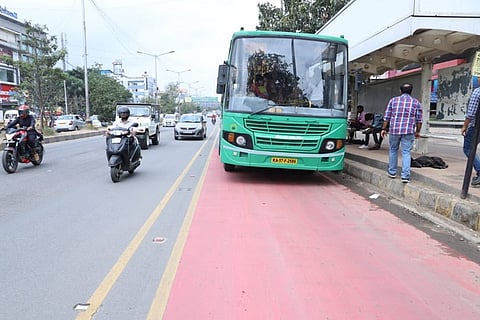

In a pre COVID-19 world, hopping on a bus or taking a metro to commute to work was a regular activity in Bengaluru. But how different will the city's modes of public transportation, where the virus can spread quickly, look when the lockdown starts being lifted?
Public transport in Bengaluru has been shut in the city since March 20, when the first lockdown was announced.
As of September 2019, 36 lakh people used buses of the Bangalore Metropolitan Transport Corporation (BMTC) daily, making it one of the most used modes of commute in the city. Now, according to its Managing Director C Shikha, BMTC bus rides will be a lot different than before.
While AC buses (820 out of a fleet of ~6,000) have been out of operation since March, senior officials said radical changes like seating only buses or capping the maximum number of passengers in buses will require additional financial support from the state government.
According to Shikha, there will be three major changes.
“First, is sanitising the buses — they will be washed and disinfected on a daily basis and we have made necessary arrangements for that. Secondly, BMTC staff will mandatorily wear masks and gloves. We provided two sets of these to everyone in March. The third aspect is that all staff will be checked daily by medical staff at the depot when they first report to the depot,” she said.
Besides this, masks will be made mandatory for all passengers.
However, on a BMTC bus, one of the biggest touchpoints is passengers exchanging cash for tickets. Shikha says that they do not think it is “appropriate” to collect cash.
“We will advocate monthly passes for regular users, so this will reduce contact. We will try to minimise cash collection to the extent it is possible. For casual users, we will go for QR code based online payment, which can be done through phones,” Shikha said.
She further added that the corporation will place educational material on the back of seats and outside buses to create awareness for maintaining physical distancing and on how to wash masks.
A standard operating procedure (SOP) is also being prepared by the BMTC following intra and inter-departmental meetings, including those chaired by Transport Minister and Deputy CM Laxman Savadi.
While BMTC buses may be the most used public transport in Bengaluru, an average of 4.15 lakh people use the Namma Metro for their daily commute. Officials working in the Bangalore Metro Rail Corporation Limited (BMRCL) said they have to wait for SOP from the Union Ministry of Housing and Urban Affairs.
Like the BMTC, the BMRCL has also floated a tender for open loop mobility cards which can be used for contactless payment. It so far only has closed loop mobility cards.
Pawan Mulukutla, an urban mobility expert, said globally the conversation around opening up of bus routes is going on, and it is agreed that around 25 persons in a bus would be an ideal number to maintain physical distancing.
“Similarly, in the metro also we need seating in alternative seats and circles/ triangles should be drawn for people to stand. 100-115 passengers per coach may be a good number to maintain,” he told TNM.
He said the financial losses that the transport authorities suffer due to this have to be compensated by the state and central governments.
For both metro and buses, he called for the authorities to try and run services targeted towards employment zones and back to residential zones. “At this point with cases still rising, there won’t be anybody necessarily going shopping or leisure travel. Schools and colleges are also likely to be shut until we start flattening the curve at a national level. The only focus should be given to users getting to work, especially in the informal sector,” he said.
Srinivas Alavilli, co-founder of Citizens for Bengaluru (CfB), said, “It is clear that Bengaluru will have a gradual exit from lockdown. We have to learn to live with COVID-19 for a long time, perhaps a year or more. Bengaluru has done remarkably well in containing the spread so far but as they ease restrictions, we need to be even more careful than the initial phases of lockdown.”
He said the city has experienced much better air quality as a result of lockdown and now there is irrefutable proof that vehicular emissions are the leading cause of pollution in our city.
According to Srinivas, the city must learn from this as it moves forward, and should promote non-motorised transport, such as cycling and walking. “Cycling is being promoted everywhere in the post-COVID-19 world and the leaders of Bengaluru must spend time understanding why and what can be done here,” he said.
Srinivas also said with less number of long distance trains running, it is the best time to start suburban trains within city limits.
Pawan also opined that this was also an ideal time to promote the usage of cycles especially for micro mobility needs. “Ideally we can make 50% of the roads for walking and cycling in all 2+ lane roads. We know where most of our offices or factories are, so we need to make those places very easily accessible through all these modes.”
Nimisha, an activist with Jhatkaa.org also said there is a need to push for cycling. “Even before COVID-19, Bengaluru was not able to sustain the traffic. Cycling is the solution,” she said.